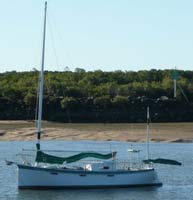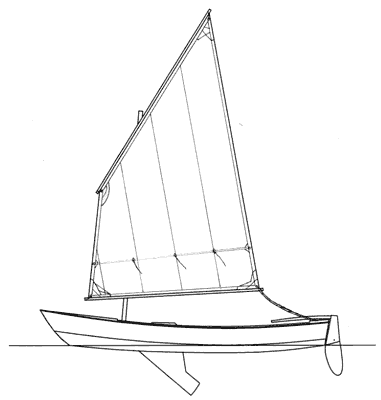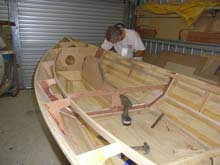In the late afternoon of a balmy North Queensland day, a man in his fifties sat in a small rowing and sailing dinghy, near the banks of a sandy estuary. It was not the great physical beauty of the mangrove-fringed inlet that was the object of his attention, but a clean-lined sailing cruiser of about thirty feet length-overall which sat quietly at anchor only a short distance from the sand.
 |
It was not the great physical beauty of the mangrove-fringed inlet that was the object of his attention, but a clean-lined sailing cruiser of about thirty feet length-overall which sat quietly at anchor only a short distance from the sand. |
As is always the case for those obsessed with boats, the man was constantly alert for the sight of something different from the normal run of fibreglass, stainless steel, and push-pit barbeques; and this particular vessel had caught his eye from a long way off. What was different about her? Well, she was free from the normal clutter of standing rigging, furled headsails, high cabin trunks and inflatables, and importantly, she was anchored in what appeared to be impossibly shallow water for a boat of her size. Above all, there was something about her character that struck him as familiar.
August and September are wonderful months way up north in the tropics, and rowing around an isolated estuary is good for the soul at a time when the sun is low – as long as you have your eyes open for crocodiles! This fellow had rowed and sailed in the particular location hundreds of times over the years, but it never lost its appeal as a sanctuary from his day-to-day work in the nearby city. His boat was a fifteen foot long plywood dinghy, fitted with the most simple of sailing rigs, along with a well-made set of leathered oars and bronze oarlocks.
The interior of the dinghy showed the evidence of frequent use – a collapsible crab pot in the forward space against the centreboard case, a large water container under the thwart, a camera in a waterproof case in a bucket aft and several sorts of other paraphernalia. The internal paintwork had endured its fair share of scratching, and the bundled sail carried grease and mud stains. But the boat was in a good, solid state of repair, and she looked like a capable sort of ship.
The man sat looking at the larger boat for several minutes, resting his hands on the handles of his nicely balanced oars. Then, with a few deft strokes, he spun the sailing dinghy in her own length and sent her in towards the sandy shore beside the object of his attention. As he passed close to the bow of the big cruiser, he noticed that the clear water was only about two feet deep, yet the anchored boat was definitely well afloat. As he continued to paddle along the length of the boat, it became apparent to the oarsman that the boat he was looking at had come from far away. She flew a foreign flag, and his experienced eye could pick the signs of a vessel which had traveled across oceans.

His boat was a fifteen foot long plywood dinghy,
fitted with the most simple of sailing rigs
Stepping ashore on the firm sand, our friend dragged the plywood sailing dinghy up until she was safe from drifting, and then he pulled a wooden galley box out from under the main thwart and set a kettle to boil over an old alcohol stove. Had he been in a more exposed location, the man would have moved the boat much further up the beach, using the pair of inflatable rollers which were currently tied up under the side decks. The boat was light enough to be manhandled by him under most circumstances, and he was very grateful that he had resisted the urge to go for a bigger dinghy at the time of construction. To himself he said, “Just like Goldilocks – not too big; not too small; but just right”.
Returning his attention to the larger vessel, he studied her details once again. She had a plumb stem, with a beautifully sharp entry at the waterline, widening out rapidly to a wall-sided midsection which terminated in a shapely stern and a vertical transom of almost triangular cross-section. The overall shape of the boat put him in mind of pictures he had seen of Thames Sailing Barges, although this one did not carry leeboards like the barges. Because the boat did not have any cabin trunk (other than what appeared to be an oversized companionway shelter), the hull sides looked quite high. However, as he waded out to her in the knee-deep water, he discovered that his eyes were almost level with her deck-line, so appearances were deceiving and he could tell that this boat was much lower than the average production boat of her size.
Steam issuing from the kettle called him ashore, and as the man settled down on the sand to drink coffee, he felt the well-known demon of “Unreasonable Boat Desire” creeping up on him once again. This thirty-footer struck him as just about the ideal escape machine with her free-standing cat-yawl rig, one-and-a-half foot draft, centreboard and clean deck-line. That she was an ocean-going craft was beyond doubt, and he could see that in comparison with the average sailing boat tied up in a marina, she would be very cheap to build and maintain. In his mind’s eye he could see himself cruising the Great Barrier Reef, sailing to New Caledonia, reeling in large fish, weathering tropical storms without the slightest concern, and living out childhood fantasies related to desert islands and buried treasure. Oh no, it was all happening again…!
Now this fellow had a close friend who was known for his conservative (some would say, “boring”) views, and as he sat dreaming about the feats he could achieve in this wonderful ocean-cruiser, he could hear his friend’s voice-of-reason sounding in the back of his head. “Don’t do it,” the voice said, “you know the boat is too big.” He shook his head, but the phantom voice continued, “You know that a big boat will drain your financial and physical resources, and that you will get far more use out of your superb little sailing dinghy.” Still the voice droned on, “You can only just manage to keep the paint up to your little boat, you lazy so-and-so; how do you expect to maintain a thirty-footer?”
 |
He had built her with his own hands, and the cost had been tiny. The returns, however, had been enormous. |
Turning to the right, the middle-aged mariner looked at his existing boat. She was light, and very good-looking. The rig was strong, simple, free-standing and easy to repair. As she sat on the sand he could see with great satisfaction that the lowered sailing rig lay nicely in a compact bundle to one side, well clear of his rowing position. Many times he had slept on-board, having set off after work to row or sail for a few hours before bedding down for the night on the sleeping platform he had fashioned inside the dinghy. With the boom tent rigged, he was well protected from insects and light rain, and the snug interior made him feel secure. After use, the boat could be tucked away in a corner of his shed until needed for the next mild adventure. Annual maintenance was minimal.
The afternoon sea-breeze being favourable, the sailor set the small boat’s rig (two minute’s work) and ran out of the inlet for an hour or so of sailing in the tropical evening, knowing that for him at least, the freedom provided by the small plywood dinghy was beyond price. He had built her with his own hands, and the cost had been tiny. The returns, however, had been enormous.
***** |

